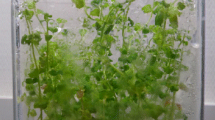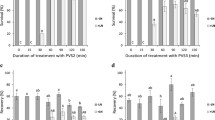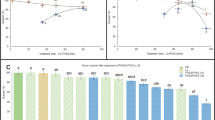Abstract
This article reports the cryopreservation of apical meristems of Chlorophytum borivilianum, a tropical and IUCN critically endangered species. Initially, in vitro cultured shoots were pre-adapted on 12% (w/v) sucrose for 2-months and were found appropriate stock material for further experimentations. Furthermore, the preculture of meristems excised from pre-adapted in vitro shoots on 12% (w/v) sucrose containing MS medium with 50 mg/l abscisic acid for 48 h, followed by treatment with loading solution (LS), and plant vitrification solution (PVS2) was found crucial for recovery following cryostorage. Thereafter, durations of exposure to the LS and PVS2 were optimized to enhance the regeneration efficiency of apical meristems. Treatment with LS for 20 min followed by 30 min exposure to PVS2 was standardized for the vitrification of the apical meristems before plunging them into liquid nitrogen. Moreover, after cryoexposure thawing was performed for 1 min at 38 °C ± 2 in a water-bath followed by the treatment with unloading solution for 10 min resulted in enhanced recovery up to 33% on 2 mg/l 6-benzyladenine (BA) and 0.2 mg/l α-naphthalene acetic acid containing MS medium.



Similar content being viewed by others
References
Chauhan R, Keshavkant S, Quraishi A (2018) Enhanced production of diosgenin through elicitation in micro-tubers of Chlorophytum borivilianum Sant et Fernand. Ind Crop Prod 113:234–239
Tripathi RK, Dethe PD, Bhojne SK, Raut AA, Rege NN (2019) A prospective, randomized, placebo-controlled, double-blind comparative pilot study to evaluate the efficacy of Chlorophytum borivilianum on physical performance. Indian J Pharmacol 51:150–156
Chauhan R, Quraishi A, Jadhav SK, Keshavkant S (2016) A comprehensive review on pharmacological properties and biotechnological aspects of Genus Chlorophytum. Acta Physiol Plant 38:116
Kaur R, Arora S, Thukral AK (2009) Enhancing seed germination of Chlorophytum borivilianum Sant et Fernand with PGRs, steroidal hormones and zinc. Res J Seed Sci 2:32–39
IUCN (2015): International union for conservation of nature and natural resources. The IUCN red list of threatened species, Version 2015–4. 2015, http://www.iucnredlist.org [Accessed September 2019]
Nayar MP, Sastry ARK (1988) Chlorophytum borivilianum. In: Nayar MP, Sastry ARK (eds) Red data book of Indian plants, vol 2. Botanical Survey of India, Calcutta (India), p 412
Pathirana R, McLachlan A, Hedderley D, Panis B, Carimi F (2016) Pre-treatment with salicylic acid improves plant regeneration after cryopreservation of grapevine (Vitis spp.) by droplet vitrification. Acta Physiol Plant 38:12
Rao NK (2004) Plant genetic resources: advancing conservation and use through biotechnology: a review. Afr J Biotechnol 3:136–145
Villalobos-Olivera A, Martínez J, Quintana N, Zevallos BE, Cejas I, Lorenzo JC et al (2019) Field performance of micropropagated and cryopreserved shoot tips derived pineapple plants grown in the field for 14 months. Acta Physiol Plant 41:34
Tandon P, Kumaria S, Das CM (2012) Plant resources of India: potentials for future development. Proc Natl Acad Sci Ind Sect B Biol Sci 82(S2):283–289
Benelli C, De Carlo A, Engelmann F (2013) Recent advances in the cryopreservation of shoot-derived germplasm of economically important fruit trees of Actinidia, Diospyros, Malus, Olea, Prunus, Pyrus and Vitis. Biotechnol Adv 31:175–185
Wen B (2019) Seed germination ecology of Alexandra palm (Archontophoenix alexandrae) and its implication on invasiveness. Sci Rep 9:4057
Rahman SM, Ahsan MN, Al-Mamun A, Hossain QZ, Rahman MM, Hasan MM, Chisty MAH (2015) Evaluating the suitability of cryoprotectants and cryopreservation solutions for Olive Barb, Puntius Sarana embryos. Proc Natl Acad Sci Ind Sect B Biol Sci 85(1):175–180
Chauhan R, Keshavkant S, Jadhav SK, Quraishi A (2016) In vitro slow-growth storage of Chlorophytum borivilianum Sant. et Fernand: a critically endangered herb. Vitro Cell Dev Biol-Plant 52:315–321
Murashige T, Skoog F (1962) A revised medium for rapid growth and bioassays with tobacco tissue cultures. Physiol Plant 15:473–497
Sakai A, Kobayashi S, Oiyama I (1990) Cryopreservation of nucellar cells of navel orange (Citrus sinensis Osb. var. Brasiliensis Tanaka) by vitrification. Plant Cell Rep 9:30–33
Chen X-L, Li J-H, Xin X, Zhang Z-E, Xin P-P, Lu X-X (2011) Cryopreservation of in vitro-grown apical meristems of Lilium by droplet-vitrification. S Afr J Bot 77:397–403
Suzuki M, Ishikawa M, Okuda H, Noda K, Kishimoto T, Nakamura T et al (2006) Physiological changes in gentian axillary buds during two-step preculturing with sucrose that conferred high levels of tolerance to desiccation and cryopreservation. Ann Bot 97:1073–1081
Engelmann F (2004) Plant cryopreservation: progress and prospects. Vitro Cell Dev Biol-Plant 40:427–433
Fang JY, Wetten A, Hadley P (2004) Cryopreservation of cocoa (Theobroma cacao L.) somatic embryos for long-term germplasm storage. Plant Sci 166:669–675
Popova EV, Lee EJ, Wu CH, Hahn EJ, Paek KY (2009) A simple method for cryopreservation of Ginkgo biloba callus. Plant Cell Tissue Organ Cult 97:337–343
Chang Y, Reed BM (2001) Preculture conditions influence cold hardiness and regrowth of Pyrus cordata shoot tips after cryopreservation. HortScience 36:1329–1333
Benson EE (2008) Cryopreservation of phytodiversity: a critical appraisal of theory and practice. Crit Rev Plant Sci 27:141–219
Santos PAA, Paiva R, Silva LC, Souza AC, Gallo CM, Herrera RC (2013) Effect of load solution and growth media on cryopreservation by droplet vitrification of Hancornia speciose shoot tips. In: VIII International Symposium on in vitro Culture and Horticultural Breeding. ISHS Acta Hortic, 1083: 507–512
Matsumoto T, Sakai A, Yamanda K (1994) Cryopreservation of in vitro grown apical meristems of wasabi (Wasabia japonica) by vitrification and subsequent high plant regeneration. Plant Cell Rep 13:442–446
Yin Z-F, Bi W-L, Chen L, Zhao B, Volk GM, Wang Q-C (2014) An efficient, widely applicable cryopreservation of Lilium shoot tips by droplet vitrification. Acta Physiol Plant 36:1683–1692
Panis B, Piette B, Swennen R (2005) Droplet vitrification of apical meristems: a cryopreservation protocol applicable to all Musaceae. Plant Sci 168:45–55
Sant R, Taylor M, Tyagi A (2006) Cryopreservation of in vitro-grown shoot-tips of tropical taro (Colocasia esculenta var. esculenta) by vitrification. Cryo Letters 27:133–142
Zamecnik J, Faltus M, Kotkova RF, Hejnak V (2011) Glass transition determination in Allium shoot tips after dehydration. Acta Hortic 908:33–38
Berjak P, Pammenter NW (2014) Cryostorage of germplasm of tropical recalcitrant seeded species: approaches and problems. Int J Plant Sci 175:29–39
Author information
Authors and Affiliations
Corresponding author
Ethics declarations
Conflict of interest
The authors declare that no conflict of interest.
Additional information
Publisher's Note
Springer Nature remains neutral with regard to jurisdictional claims in published maps and institutional affiliations.
Significance Statement: For the cryopreservation of Chlorophytum borivilianum abscisic acid was found crucial that helps in freeze tolerance. Moreover, the exposure times to cryoprotectants were optimized which minimizes the toxicity and helps in regeneration of meristems.
Rights and permissions
About this article
Cite this article
Chauhan, R., Singh, V., Keshavkant, S. et al. Vitrification-Based Cryopreservation of In Vitro-Grown Apical Meristems of Chlorophytum borivilianum Sant et Fernand: A Critically Endangered Species. Proc. Natl. Acad. Sci., India, Sect. B Biol. Sci. 91, 471–476 (2021). https://doi.org/10.1007/s40011-021-01260-z
Received:
Revised:
Accepted:
Published:
Issue Date:
DOI: https://doi.org/10.1007/s40011-021-01260-z




